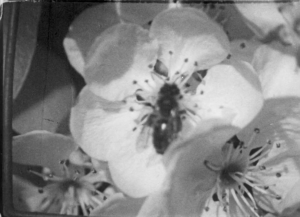
Documentary about bees, with impressive and detailed images. One of the best examples of the educational documentaries of the movement, which caught the attention of the Catalan Cinema Committee.
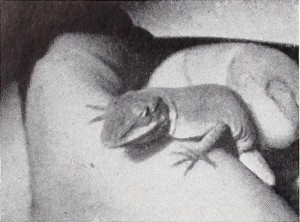
"To film an insect well, when it is crawling, creeping or flying, is a real feat. Francis M. Spoonogle does this with great success. In his film, Backyard Zoo, he has taken completely undirectable creatures and has managed to capture them on film with such intimacy as to give one the feeling that he might be living for a while in the insect world. Unsuspected beauty is revealed in the coloring of caterpillars with normally unseen fur collars. So sharply has he focused on insect life in this beautiful 8mm. film that the "feathers," making up the coating of a butterfly's wings, are almost discernible." Movie Makers, Dec. 1945, 495-496.
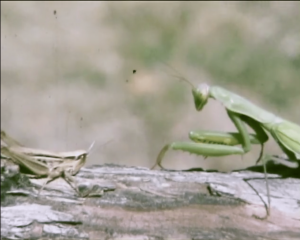
La mantis religiosa o “Santa Teresa” es un pequeño insecto que abunda en nuestros campos. En su extraña apariencia encierra instintos caníbales, lo que hace que la hembra, con mucha frecuencia, devore al macho durante o después de su apareamiento. La película recoge los distintos aspectos de la vida de la mantis religiosa. (Bienal de cine científico español, 1983)
The praying mantis or "Saint Theresa" is a small insect abundant in our fields. In its strange appearance, lie cannibal instincts, often provoking the female mantis to devour the male mantis during or after mating. The film depicts the different aspects of the praying mantis' life. (Bienal de cine científico español, 1983)
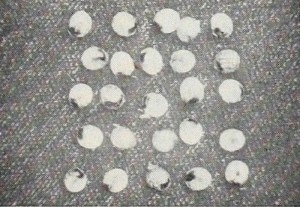
"Citheronia Regalis, the Royal Walnut Moth, or Hickory Horned Devil are some of the ringing appellations admiring entomologists have given the colorful caterpillar on which Jay T. Fox has chosen to turn his microcinematographic attention. The result, The Birth of a Caterpillar, is an excellent example of scientific filming. In it, Mr. Fox records the egg, embryonic and finally emerging stages of his subject with sound scientific knowledge, exceptional technical ability and obvious patience." Movie Makers, Dec. 1950, 468.
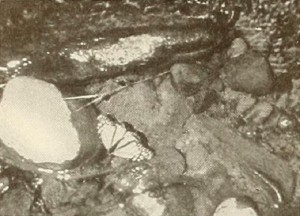
"The very great faculty of Robert P. Kehoe for seeing natural beauty and giving it an individual and entirely original expression in film enables him, in Brookside, to reach a new height in cinematography, because he has added to that faculty an attention to the business of continuity. Like Tennyson's Brook, Mr. Kehoe"s film starts to go somewhere, keeps going and gets there, while we who watch the going see, by the brookside, some of the loveliest — but tripodless — footage of water, flowers and woodland that any landscapist could want to come by. The final sequence of Mr. Kehoe's picture has a tragic tenderness that is almost too poignant, since he has filmed the funeral progress down the darting brook of a lustrous butterfly that ventured too close to the water and was sucked into it. With wings outspread, the little body goes past us into '"yesterday's ten thousand years" as the film ends." Movie Makers, Dec. 1941, 565.
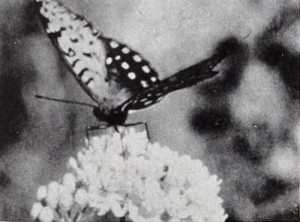
"The late and unlamented war kept amateur movie makers — along with the rest of peripatetic America — pretty close to their backyards. Robert S. Walker is one who has made this restriction pay dividends. The result is Butterflies, a charming study of these winged wanderers of blossomland. Those filmers who have ventured into the field of extreme closeup work will understand and applaud the patient skill with which Mr. Walker got wellnigh perfect results in recording each new specimen. Rhymed quatrains serve, with the scenes, to create a film of light and airy entertainment." Movie Makers, Dec. 1945, 496.
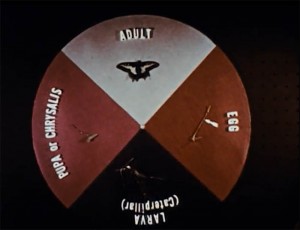
"The Butterfly with Four Birthdays is a well done documentary on the life cycle of the Anise Swallowtail (Papilio Zelicaon). The Zelicaon, often mistaken for the Monarch, lives in the Western United States and lays her eggs on the anise plant, also known as sweet fennel. From the egg comes the baby caterpillar, thirdly the pupa or chrysalis stage, and finally, on its fourth birthday, the butterfly. This film also received the MPD Nature Film Award" PSA Journal, Sept. 1965, 50.
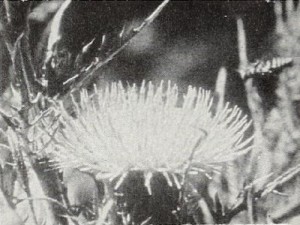
"The recipe for a film like Dad and I Took a Walk sounds simple enough. You take equal parts of Father and Son, add a cupful of scenery, season with judicious pinches of natural science — and cook till done. The secret, apparently, lies with the "cook till done" section; so much depends on the cook. But W. W. Vincent, jr., is a good chef, to judge by the results from his cinematic oven. In clean cut, tripod steady Kodachrome, he and his son are seen roaming the pleasant Wisconsin landscape, with nicely timed pauses to point out, one to the other, a nesting robin, a praying mantis or a bright snake asleep in the warming sun. As the two men discuss their finds, spoken titles are double exposed against appropriate backgrounds or the pages of a bird manual are inserted naturally in full frame closeups. Dad and I Took a Walk is an attractive blend of personal filmdom's most popular subjects — field, family and fauna." Movie Makers, Dec. 1942, 508.
"The dependence of all living things on water. The physical properties of water; water as a habitat for such creatures as insects, birds, beavers, frogs; use and abuse of water resources by man." (BC Archives)
Total Pages: 5